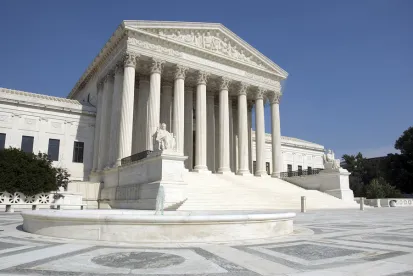The Court handed down two of the second-tier blockbusters of the term, this morning: South Dakota v. Wayfair (No. 17-494), reversing Quill Corp. v. North Dakota (1992) and permitting states to force out-of-state sellers to collect and remit sales tax even if the sellers lack a physical presence in the state; and Lucia v. SEC (No. 17-1330), reversing the D.C. Circuit and holding that the SEC's ALJs are "Officers of the United States," subject to the Appointments Clause. The Court also decided Pereira v. Sessions (No. 17-459), holding that a notice to appear does not interrupt an undocumented immigrant's period of continuous presence if it does not provide the time and place at which the removal hearing will be held, and Wisconsin Central v. United States (No. 17-530), holding that employee stock options are not taxable "compensation" under the Railroad Retirement Tax Act because they are not "money remuneration." All in all, a pretty big day at One First Street, but bigger days are yet to come! There is another opinion day scheduled for tomorrow, and we expect at least one (more likely two) next week, as well. Clearly, we've got our work cut out for us, but as Cass Sunstein might say, we'll take it "one case at a time." Here, then, are summaries of Mondays non-gerrymandering cases, to tide you over until we get to today's offerings.
In a Term that's seen a number of sui generis decisions, Lozman v. City of Riviera Beach (No. 17-21)may be the sui-est of them all. The Court was asked to decide whether the existence of probable cause defeats a First Amendment retaliatory-arrest claim as a matter of law. But, in what has become a trend this Term, the Court largely dodged the broader legal question and resolved the case narrowly on the idiosyncrasies of the case, holding that with "facts like these," the petitioner, Fane Lozman, could proceed with his retaliatory-arrest claim. And, if you've followed Lozman's saga at all, you'll appreciate just how idiosyncratic "facts like these" are.
Lozman's legal odyssey began in 2006, when he moved his "floating home" to a marina owned by the City of Riviera Beach. The City was in the midst of a plan to redevelop its waterfront and wanted Lozman to shove off, so they brought a federal admiralty suit to evict him. But, in his first trip to the Supreme Court, Lozman persuaded the Court that the federal courts lacked admiralty jurisdiction because the home, which had no rudder or means of self-propulsion, was not in fact a "vessel." Meanwhile, the City continued with its redevelopment efforts and Lozman remained an outspoken critic of its plans to seize waterfront property for private development. He spoke at Council meetings and filed a lawsuit against the City, becoming persona non grata in the nice, quiet little beach community. Tensions came to a head at a November 2005 Council meeting, at which Lozman used his time during the public-comment session to discuss the recent arrests of county and city officials in nearby West Palm Beach. A Riviera Beach councilman interrupted Lozman and asked him to stop speaking. When Lozman persisted, the councilmember directed a police officer in the room to carry him away. Lozman was handcuffed, transported to police headquarters, and charged with disorderly conduct and resisting arrest without violence. The charges were later dismissed, and Lozman filed a § 1983 lawsuit against the City alleging, among other things, that he was arrested in retaliation for his speech, thereby violating his First Amendment rights. So began his second trip to the Supreme Court.
The District Court found that there was insufficient evidence of probable cause to arrest Lozman for disorderly conduct or resisting arrest, but that a jury might reasonably find that there was probable cause to arrest him for interrupting or disturbing a public assembly, in violation of Fla. Stat. § 871.01, even though he hadn't been charged under that statute. A jury then rejected Lozman's retaliatory arrest claim, and the Eleventh Circuit affirmed the judgment on the ground that the jury had necessarily determined the arrest was supported by probable cause, which the court deemed a defense to the First Amendment retaliatory arrest claim. Before the Supreme Court, Lozman conceded that there was probable cause to arrest him under § 871.01, but argued that the existence of probable cause to arrest him for some offense shouldn't bar his retaliation claim where the circumstances of the case made it so clear that he was in fact arrested for exercising his First Amendment rights and not for causing a public disturbance.
In a brief opinion authored by Justice Kennedy and joined by all but Thomas, the Court sided with Lozman yet again. The Court framed the central tension between two precedents: Mt. Healthy City Board of Education v. Doyle (1977), which held that a claim of First Amendment retaliation in the government employment context turned on whether the retaliatory motive was a but-for cause of the government's action; and Hartman v. Moore (2006), which held that a First Amendment retaliatory prosecution claim against law enforcement officers cannot be sustained if probable cause to prosecute exists. After observing that both precedents were distinguishable from the facts before it, the Court concluded that the difficult task of reconciling the competing precedents "must await a different case." In this case, hoping to avoid creating a "flood of retaliatory arrest suits," the Court ruled narrowly that probable cause was not a bar to Lozman's suit in light of the atypical circumstances present. Lozman was not suing an arresting police officer; he was alleging that the City itself deliberately ordered his arrest as part of a plan to intimidate him in retaliation for his criticism of government officials. The Court found such official, high-level retaliation to be especially troubling and distinguished it from the ad hoc decision-making of individual police officers. Moreover, Lozman alleged that the retaliation was motivated by the course of events, including core First Amendment-protected speech occurring prior to the November 2006 meeting that almost certainly could not have been a legitimate, good faith basis to arrest him for interrupting or disturbing that meeting.
The lone dissenter, Justice Thomas, criticized the majority for dodging the legal issue that had split lower courts and was squarely presented to the Court to resolve. In his view, the majority had gone "out of [its] way to fashion a complicated rule with no apparent applicability to this case or any other." Instead, he would have held that the absence of probable cause is a necessary prerequisite for any First Amendment retaliatory-arrest claim and that Lozman's particular case doesn't deserve special treatment. To hold otherwise, Thomas insisted would impede effective law enforcement and open the floodgates to retaliatoryretaliatory-arrest claims.
Although Lozman, an average (if litigious) Joe, is now 2-0 before the Supreme Court, his struggle continues. The Court remanded his case for consideration of whether retaliation was in fact a but-for cause of his arrest and whether the arrest constituted an official act on the part of the City. In the meantime, he celebrated his victory by, you guessed it, showing up to yesterday's City Council meeting for a victory lap, and somehow managing not to get arrested.
Although perhaps not as entertaining as Lozman, the Court's decision in Rosales-Mireles v. United States (No. 16-9493), will likely have a far greater impact, at least for criminal defendants and their appellate lawyers. In a 7-2 decision, the Court rejected the Fifth Circuit's onerous "shocks the conscious" standard for determining whether an unobjected-to plain error should be noticed on appeal and held that appellate courts should exercise their discretion to vacate a sentence that is based on a miscalculated Guidelines range in "the ordinary case" provided that the error is "plain" and affects the defendant's substantial rights.
As our crim-pro buffs know, under the rule in United States v. Olano (1993) an error in a criminal proceeding that is not raised in the district court may be considered on appeal only if the error (1) was not "intentionally relinquished or abandoned"; (2) is "plain"; (3) "affected the defendant's substantial rights"' and—if the first three conditions are met—(4) "seriously affects the fairness, integrity or public reputation of judicial proceedings." Rosales-Mireles concerned the fourth prong of the Olano test. Rosales-Mireles was convicted of illegal reentry and sentenced under a miscalculated Guidelines range that inadvertently counted one of his prior convictions twice. As a result, the Probation Office calculated his Guidelines range to be 77 to 96 months, when the correct range was 70 to 87 months. Rosales-Mireles's trial counsel did not catch the error and the District Court, relying on the miscalculated range, sentenced him to 78 months of imprisonment. On appeal, Rosales-Mireles challenged the erroneous Guidelines range for the first time. Although the Fifth Circuit recognized that the error was plain and affected his substantial rights, it held that he had not satisfied Olano's fourth prong, implicating the fairness and integrity of the judicial proceedings because neither the error nor the resulting sentence "would shock the conscience."
In a 7-2 opinion authored by Justice Sotomayor, the Court held that the Fifth Circuit's "shock the conscience" standard is too restrictive, and lacks support in either the text of Rule 52(b) or in the Court's plain error doctrine. The Court also rejected the Fifth Circuit's emphasis on errors that amount to a "powerful indictment" of the justice system or call into question a district court's "competence or integrity," as an unwarranted narrowing of Olano's instruction to correct an error if it seriously affects "judicial proceedings." Because an error that results in a higher Guidelines range usually creates a reasonable probability that a criminal defendant will serve a prison sentence greater than "necessary" to satisfy the purposes of incarceration expressed in 18 U.S.C. § 3553(a), Justice Sotomayor explained that such an error alone—given the risk it carries of an unwarranted deprivation of liberty—is generally one that undermines the fairness, integrity or reputation of judicial proceedings. She distinguished cases that had called for more sparing plain-error review, noting that those cases generally involved errors that would require additional jury proceedings to correct on remand, whereas a sentencing remand is relatively simple and inexpensive.
Justice Thomas dissented, joined by Alito. He argued that the majority's new rebuttable presumption that Guidelines errors rise to the level of plain error is one that contravenes Olano's inherently fact-specific standard as well as the Court's prior pronouncements that plain-error relief should be afforded in only "exceptional circumstances." He also griped that Rosales-Mireles's 78-month sentence was within the correct Guidelines range, and therefore would have been regarded as presumptively reasonable if the sentencing judge had imposed the same sentence after considering the correct range. Finally, he argued that the Court's decision would reward defendants who "sandbag" appellate courts with belated objections by affording a more generous standard that they might not have benefitted from below. (To this, Justice Sotomayor responded that, aside from ethical concerns, a defense lawyer would be unlikely to subject her client to a higher Guidelines range at sentencing based on the slim chance she'd be able to vacate the sentence and then get a better shake from the same judge she'd "sandbagged.")
Finally (for today), in Chavez-Meza v. United States (No. 17-5639), the Court addressed the extent to which a sentencing judge must provide a reasoned explanation for a sentence modification under § 3553(c)(2), which permits sentencing reductions when the U.S. Sentencing Commission lowers an applicable Guidelines range. Chavez-Meza had pleaded guilty to possession of methamphetamine with intent to distribute and was initially sentenced to 135 months, which was the bottom of the then-applicable Guidelines range. The Sentencing Commission subsequently lowered the applicable range to 108-135 months, and Chavez-Meza sought a reduction under § 3553(c)(2), arguing that his sentence should be lowered to the bottom of the new range. The District Court granted his motion for a sentence reduction, but lowered his sentence only to 114 months, not 108. The sentencing judge gave no explanation for the new sentence, aside from entering his order on a form certifying that he had "considered" Chavez-Meza's "motion" and "tak[en] into account" the necessary sentencing factors under § 3553(a). Chavez-Meza appealed, arguing that the sentencing judge failed adequately to explain the rejection of his 108-month request, which would have been "proportional" to his original bottom-of-the-range sentence. The Tenth Circuit rejected his challenge, and so did The Supremes (5-3, with Gorsuch recused).
Writing for the majority, Justice Breyer began by rejecting the Government's argument that district courts have no obligation to provide on-the-record explanations for re-sentencing decisions, as opposed to original sentencing decisions. Breyer assumed that a district court's duty when modifying a sentence is equivalent to its duty when the initial sentence is imposed, but concluded that a resentencing is not a "plenary resentencing proceeding" requiring all new justifications and explanations for the sentence. Instead, some of the burden of providing a reasoned basis for a resentencing decision could be taken up by the record in the original sentencing proceeding. Here, because it was the same judge who originally sentenced Chavez-Meza and reduced his sentence, the record contained a reasonable amount of information about the judge's views of what an appropriate reduction should be. It showed, for instance, that the judge had considered and rejected Chavez-Meza's original request for a downward variance due to the severity of the offense and the significance of the drug quantity. That explanation also provided a "reasoned basis" for the same judge's decision not to lower Chavez-Meza's sentence all the way down to the bottom of the new Guidelines range. Breyer also rejected Chavez-Meza's argument that the judge was required to explain why the new sentence was not "proportional" to the point selected in the higher Guidelines range, finding no basis for that requirement in the statutory text or the Court's precedents.
Justice Kennedy, joined by Justices Sotomayor and Kagan, dissented. He noted that his disagreement with the majority opinion turned on a small difference that could be corrected with only a minor expansion of the form the judge had completed in issuing his sentence modification. By extending the form to include some of the categories that often bear on a district court's sentencing determinations, Justice Kennedy believed Chavez-Meza's objections could be addressed. While Kennedy agreed with the Court's finding that there is no presumption favoring proportional sentencing reductions, he noted that non-proportional reductions could signal a change in the district court's reasons for imposing a particular sentence that the standard form might not encompass, thus warranting a more detailed explanation. He was unwilling to entertain the majority's assumption that the sentencing judge's remarks on the quantity of the methamphetamine in Chavez-Meza's initial sentencing provided a reasoned basis for the modification, maintaining that, in fact, the reason for the new sentence was a "mystery." Kennedy also challenged the Court's holding from an efficiency perspective. Instead of inviting appellate courts to speculate about the district court's reasoning upon resentencing, as he believed the majority did here, he argued that adding "a sentence or two at the front end" would prevent the likely dozens of pages of briefing, bench memos, orders, and opinions that would follow in future cases. Conscious of the fact that Guidelines amendments can result in thousands of resentencings, Kennedy would have preferred a rule that it believed would have provided a clearer roadmap for appellate review.






 />i
/>i

